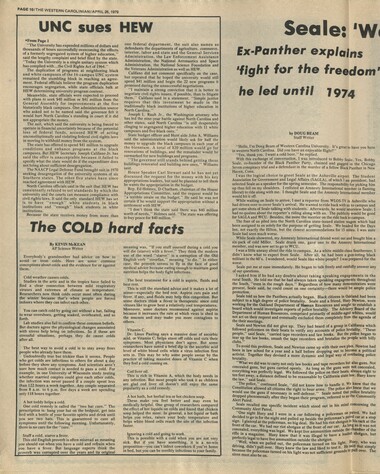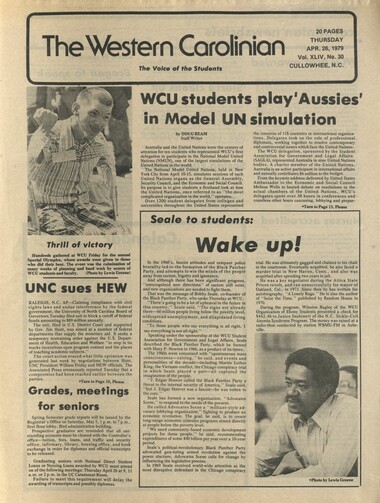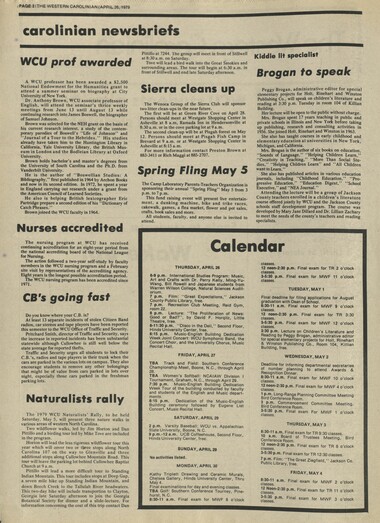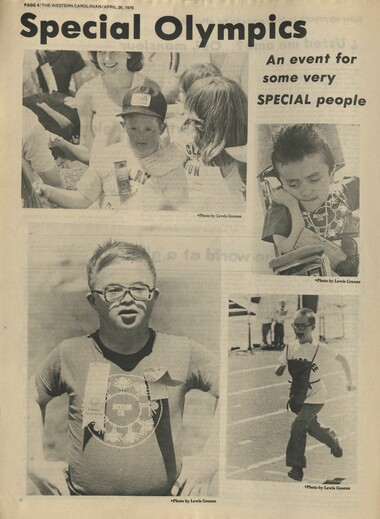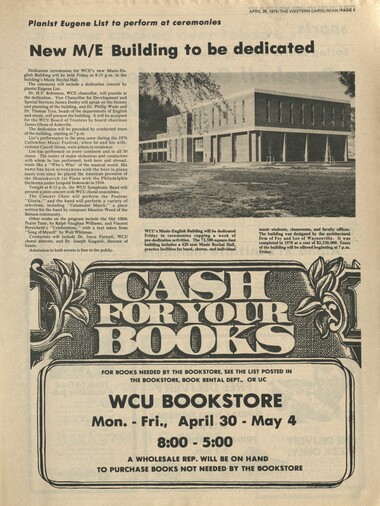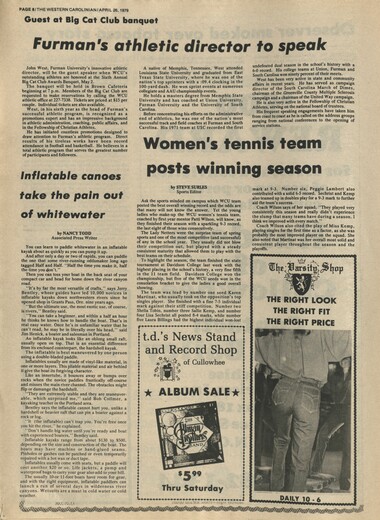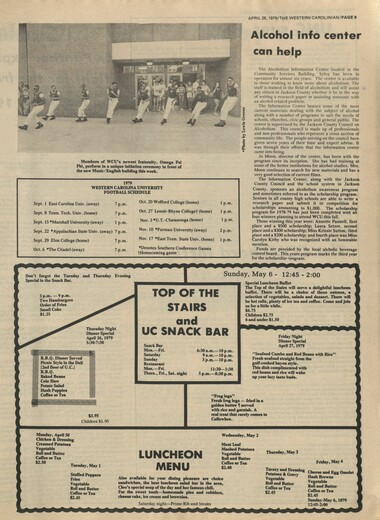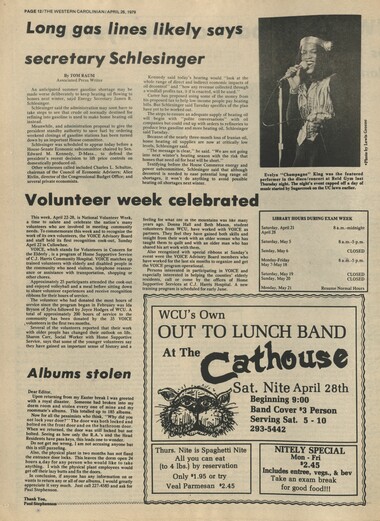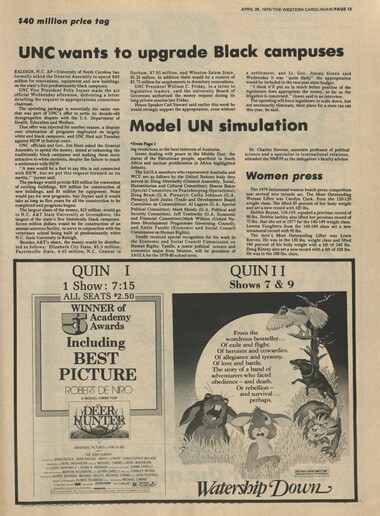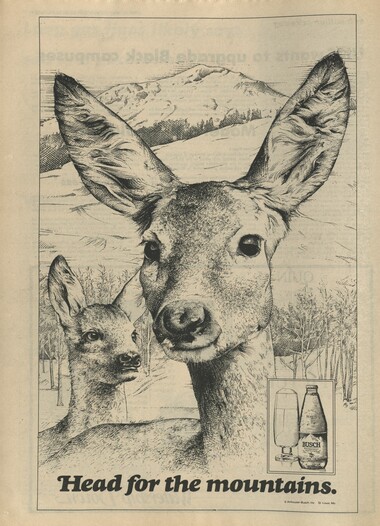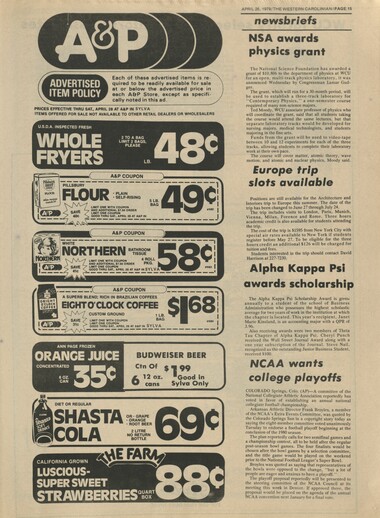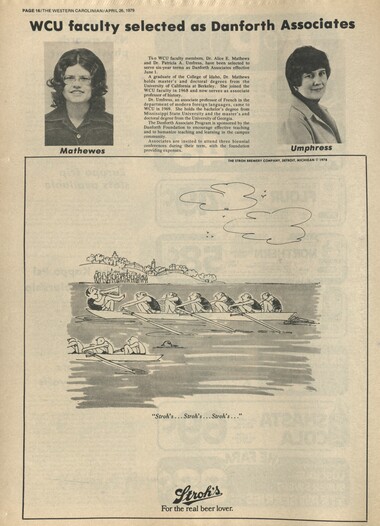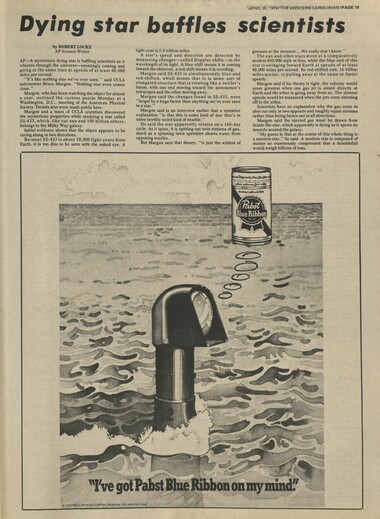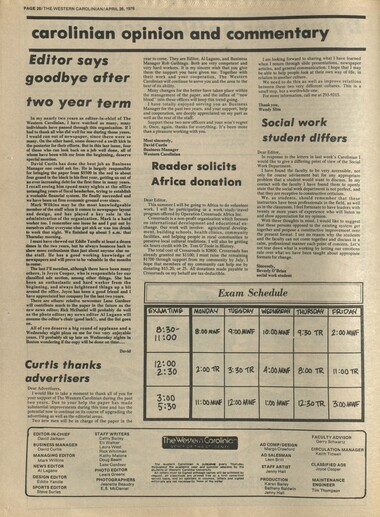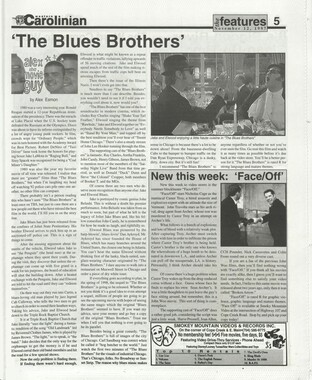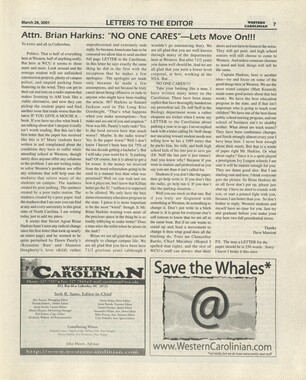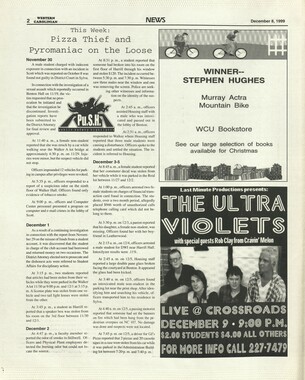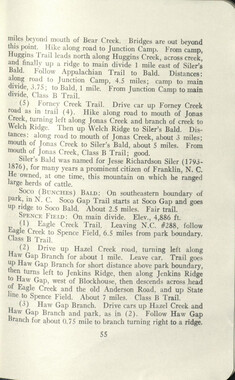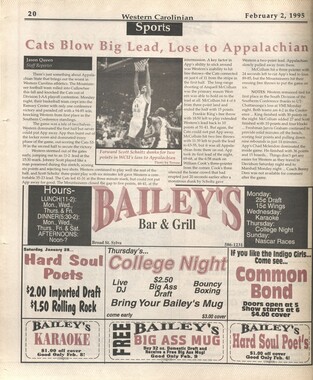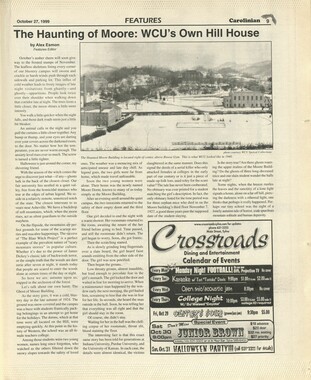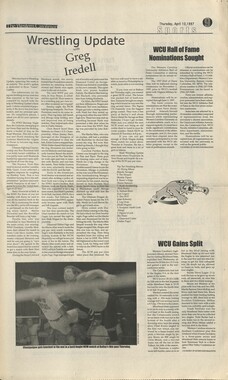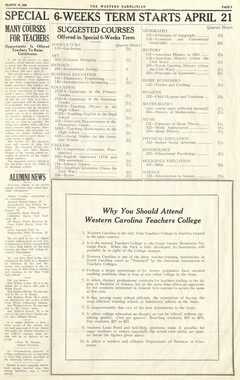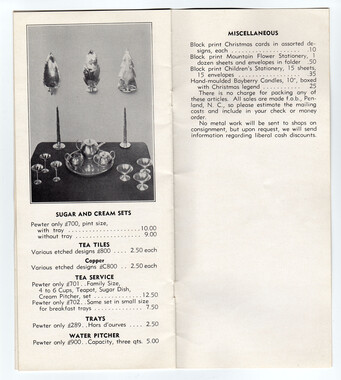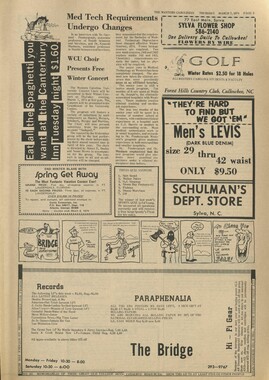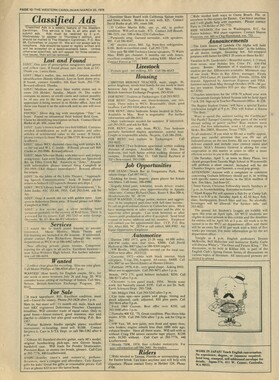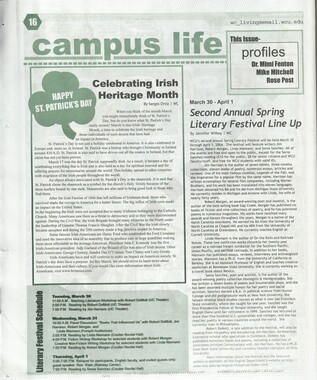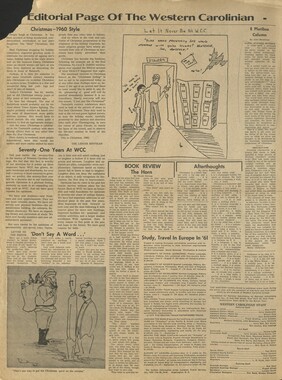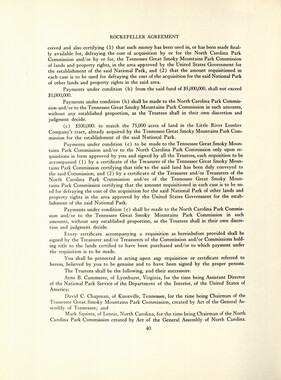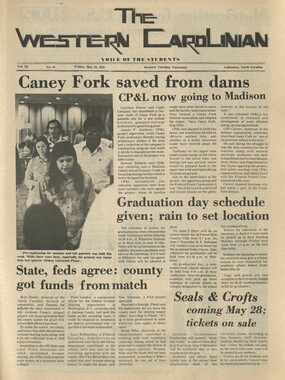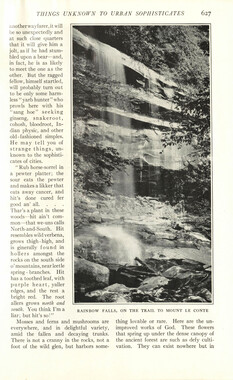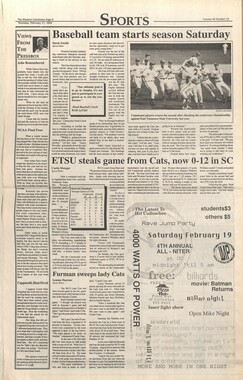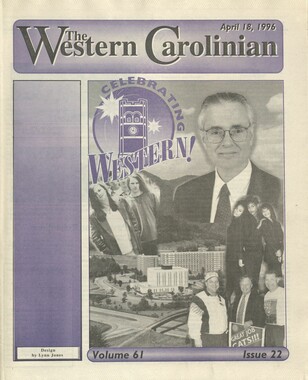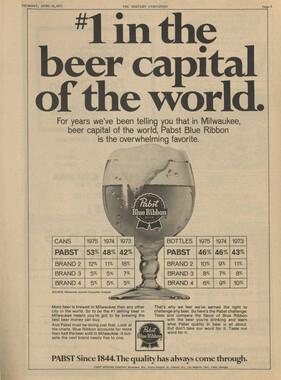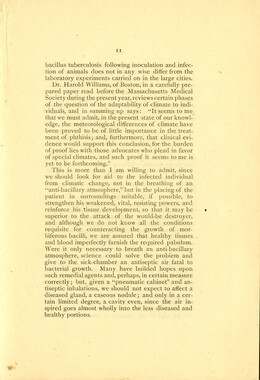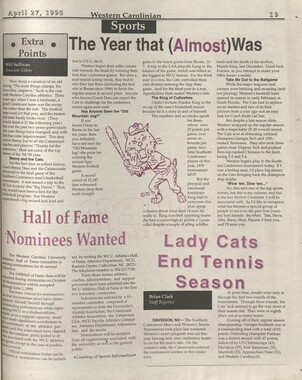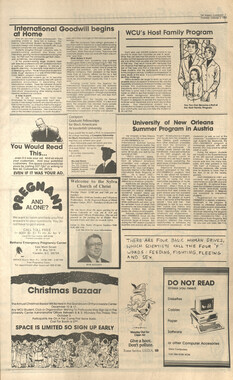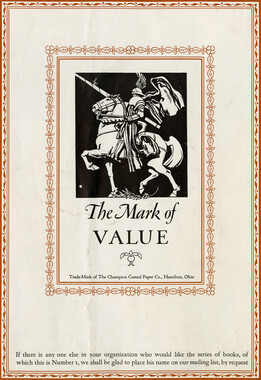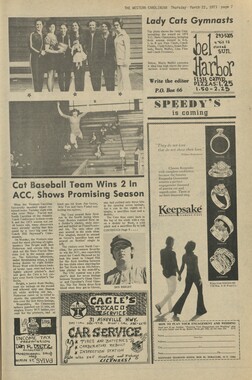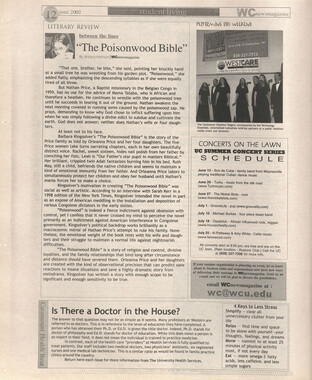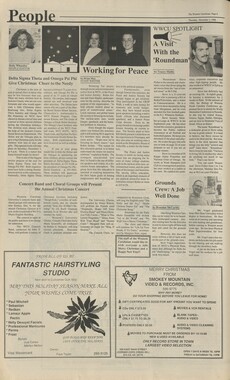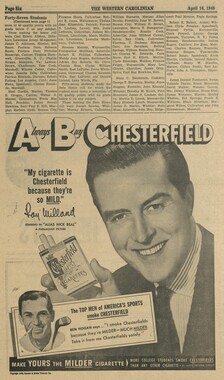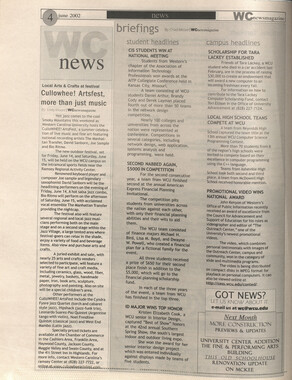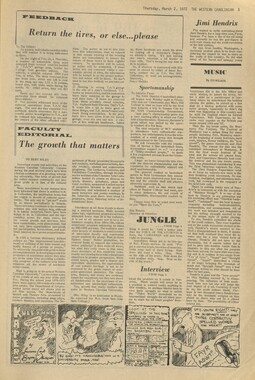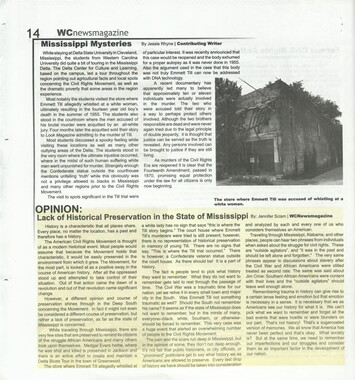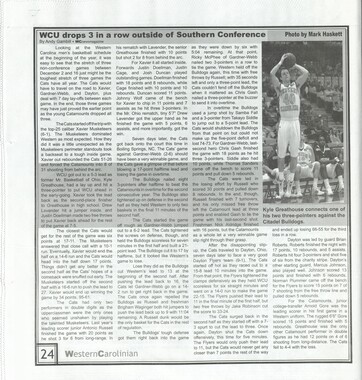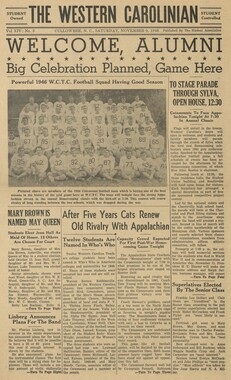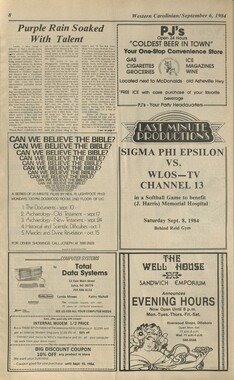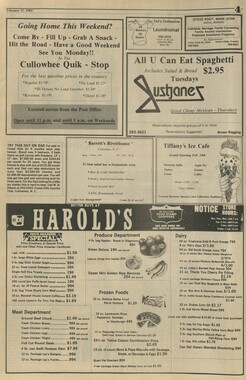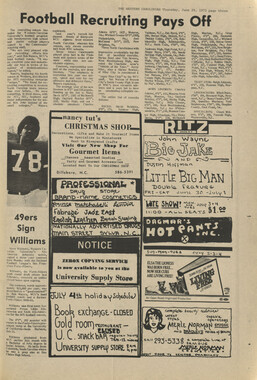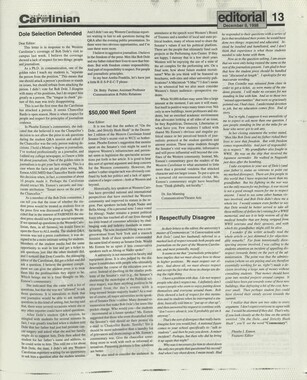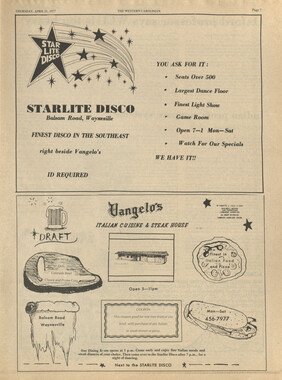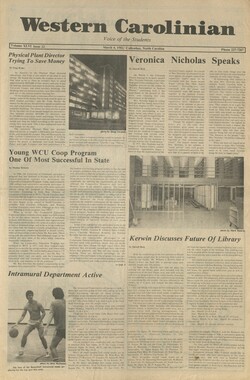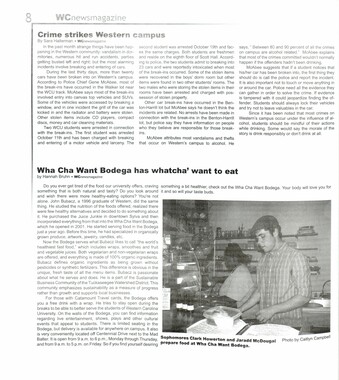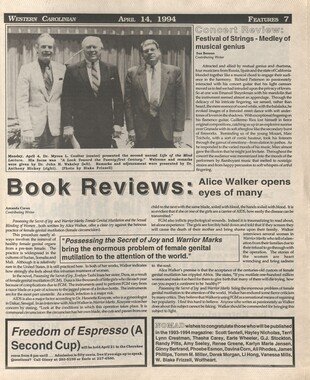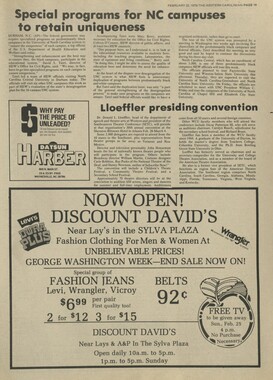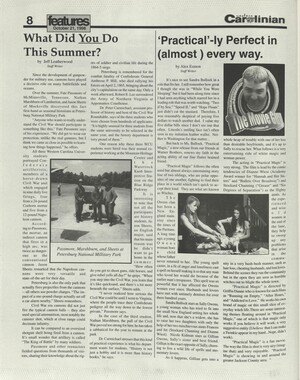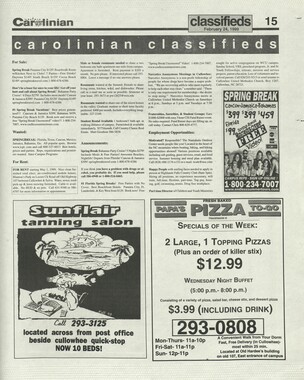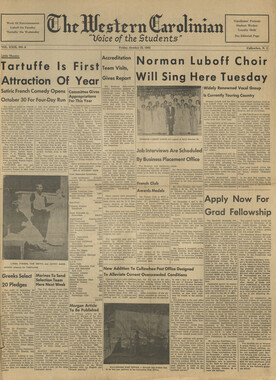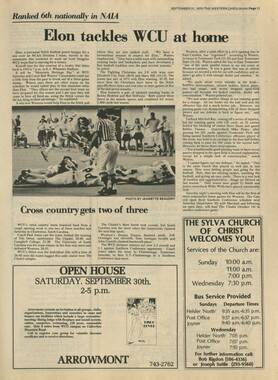Western Carolina University (21)
View all
- Canton Champion Fibre Company (2308)
- Cherokee Traditions (291)
- Civil War in Southern Appalachia (165)
- Craft Revival (1942)
- George Masa Collection (137)
- Great Smoky Mountains - A Park for America (3182)
- Highlights from Western Carolina University (422)
- Horace Kephart (998)
- Journeys Through Jackson (159)
- LGBTQIA+ Archive of Jackson County (90)
- Oral Histories of Western North Carolina (318)
- Picturing Appalachia (6617)
- Stories of Mountain Folk (413)
- Travel Western North Carolina (153)
- Western Carolina University Fine Art Museum Vitreograph Collection (129)
- Western Carolina University Herbarium (92)
- Western Carolina University: Making Memories (738)
- Western Carolina University Publications (2491)
- Western Carolina University Restricted Electronic Theses and Dissertations (146)
- Western North Carolina Regional Maps (71)
- World War II in Southern Appalachia (131)
University of North Carolina Asheville (6)
View all
- Allanstand Cottage Industries (62)
- Appalachian National Park Association (53)
- Bennett, Kelly, 1890-1974 (1463)
- Berry, Walter (76)
- Brasstown Carvers (40)
- Carver, George Washington, 1864?-1943 (26)
- Cathey, Joseph, 1803-1874 (1)
- Champion Fibre Company (233)
- Champion Paper and Fibre Company (297)
- Cherokee Indian Fair Association (16)
- Cherokee Language Program (22)
- Crowe, Amanda (40)
- Edmonston, Thomas Benton, 1842-1907 (7)
- Ensley, A. L. (Abraham Lincoln), 1865-1948 (275)
- Fromer, Irving Rhodes, 1913-1994 (70)
- George Butz (BFS 1907) (46)
- Goodrich, Frances Louisa (120)
- Grant, George Alexander, 1891-1964 (96)
- Heard, Marian Gladys (60)
- Kephart, Calvin, 1883-1969 (15)
- Kephart, Horace, 1862-1931 (313)
- Kephart, Laura, 1862-1954 (91)
- Laney, Gideon Thomas, 1889-1976 (439)
- Masa, George, 1881-1933 (61)
- McElhinney, William Julian, 1896-1953 (44)
- Niggli, Josephina, 1910-1983 (10)
- North Carolina Park Commission (105)
- Osborne, Kezia Stradley (9)
- Owens, Samuel Robert, 1918-1995 (11)
- Penland Weavers and Potters (36)
- Roberts, Vivienne (15)
- Roth, Albert, 1890-1974 (142)
- Schenck, Carl Alwin, 1868-1955 (1)
- Sherrill's Photography Studio (2565)
- Southern Highland Handicraft Guild (127)
- Southern Highlanders, Inc. (71)
- Stalcup, Jesse Bryson (46)
- Stearns, I. K. (213)
- Thompson, James Edward, 1880-1976 (226)
- United States. Indian Arts and Crafts Board (130)
- USFS (683)
- Vance, Zebulon Baird, 1830-1894 (1)
- Weaver, Zebulon, 1872-1948 (58)
- Western Carolina College (230)
- Western Carolina Teachers College (282)
- Western Carolina University (2008)
- Western Carolina University. Mountain Heritage Center (18)
- Whitman, Walt, 1819-1892 (10)
- Wilburn, Hiram Coleman, 1880-1967 (73)
- Williams, Isadora (3)
- Cain, Doreyl Ammons (0)
- Crittenden, Lorraine (0)
- Rhodes, Judy (0)
- Smith, Edward Clark (0)
- Appalachian Region, Southern (3032)
- Asheville (N.C.) (1945)
- Avery County (N.C.) (26)
- Blount County (Tenn.) (200)
- Buncombe County (N.C.) (1680)
- Cherokee County (N.C.) (283)
- Clay County (N.C.) (556)
- Graham County (N.C.) (247)
- Great Smoky Mountains National Park (N.C. and Tenn.) (535)
- Haywood County (N.C.) (3573)
- Henderson County (N.C.) (70)
- Jackson County (N.C.) (4926)
- Knox County (Tenn.) (61)
- Knoxville (Tenn.) (21)
- Lake Santeetlah (N.C.) (14)
- Macon County (N.C.) (421)
- Madison County (N.C.) (216)
- McDowell County (N.C.) (39)
- Mitchell County (N.C.) (135)
- Polk County (N.C.) (35)
- Qualla Boundary (982)
- Rutherford County (N.C.) (78)
- Swain County (N.C.) (2187)
- Transylvania County (N.C.) (270)
- Watauga County (N.C.) (12)
- Waynesville (N.C.) (86)
- Yancey County (N.C.) (72)
- Aerial Photographs (3)
- Aerial Views (60)
- Albums (books) (4)
- Articles (1)
- Artifacts (object Genre) (228)
- Bibliographies (1)
- Biography (general Genre) (2)
- Cards (information Artifacts) (38)
- Clippings (information Artifacts) (193)
- Copybooks (instructional Materials) (3)
- Crafts (art Genres) (622)
- Depictions (visual Works) (21)
- Design Drawings (1)
- Digital Moving Image Formats (2)
- Drawings (visual Works) (185)
- Envelopes (115)
- Exhibitions (events) (1)
- Facsimiles (reproductions) (1)
- Fiction (general Genre) (4)
- Financial Records (12)
- Fliers (printed Matter) (67)
- Glass Plate Negatives (381)
- Guidebooks (2)
- Internegatives (10)
- Interviews (823)
- Land Surveys (102)
- Letters (correspondence) (1070)
- Manuscripts (documents) (618)
- Maps (documents) (177)
- Memorandums (25)
- Minutes (administrative Records) (59)
- Negatives (photographs) (6192)
- Newsletters (1290)
- Newspapers (2)
- Notebooks (8)
- Occupation Currency (1)
- Paintings (visual Works) (1)
- Pen And Ink Drawings (1)
- Periodicals (194)
- Personal Narratives (10)
- Photographs (12977)
- Plans (maps) (1)
- Poetry (6)
- Portraits (4573)
- Postcards (329)
- Programs (documents) (181)
- Publications (documents) (2444)
- Questionnaires (65)
- Relief Prints (26)
- Sayings (literary Genre) (1)
- Scrapbooks (282)
- Sheet Music (2)
- Slides (photographs) (402)
- Songs (musical Compositions) (2)
- Sound Recordings (802)
- Specimens (92)
- Speeches (documents) (18)
- Tintypes (photographs) (8)
- Transcripts (329)
- Text Messages (0)
- A.L. Ensley Collection (275)
- Appalachian Industrial School Records (7)
- Appalachian National Park Association Records (336)
- Axley-Meroney Collection (2)
- Bayard Wootten Photograph Collection (20)
- Bethel Rural Community Organization Collection (7)
- Blumer Collection (5)
- C.W. Slagle Collection (20)
- Canton Area Historical Museum (2110)
- Carlos C. Campbell Collection (564)
- Cataloochee History Project (64)
- Cherokee Studies Collection (4)
- Daisy Dame Photograph Album (5)
- Daniel Boone VI Collection (1)
- Doris Ulmann Photograph Collection (112)
- Elizabeth H. Lasley Collection (1)
- Elizabeth Woolworth Szold Fleharty Collection (4)
- Frank Fry Collection (95)
- George Masa Collection (173)
- Gideon Laney Collection (452)
- Hazel Scarborough Collection (2)
- Hiram C. Wilburn Papers (28)
- Historic Photographs Collection (236)
- Horace Kephart Collection (861)
- Humbard Collection (33)
- Hunter and Weaver Families Collection (1)
- I. D. Blumenthal Collection (4)
- Isadora Williams Collection (4)
- Jesse Bryson Stalcup Collection (47)
- Jim Thompson Collection (224)
- John B. Battle Collection (7)
- John C. Campbell Folk School Records (80)
- John Parris Collection (6)
- Judaculla Rock project (2)
- Kelly Bennett Collection (1482)
- Love Family Papers (11)
- Major Wiley Parris Civil War Letters (3)
- Map Collection (12)
- McFee-Misemer Civil War Letters (34)
- Mountain Heritage Center Collection (4)
- Norburn - Robertson - Thomson Families Collection (44)
- Pauline Hood Collection (7)
- Pre-Guild Collection (2)
- Qualla Arts and Crafts Mutual Collection (12)
- R.A. Romanes Collection (681)
- Rosser H. Taylor Collection (1)
- Samuel Robert Owens Collection (94)
- Sara Madison Collection (144)
- Sherrill Studio Photo Collection (2558)
- Smoky Mountains Hiking Club Collection (616)
- Stories of Mountain Folk - Radio Programs (374)
- The Reporter, Western Carolina University (510)
- Venoy and Elizabeth Reed Collection (16)
- WCU Gender and Sexuality Oral History Project (36)
- WCU Mountain Heritage Center Oral Histories (25)
- WCU Oral History Collection - Mountain People, Mountain Lives (71)
- WCU Students Newspapers Collection (1923)
- Western North Carolina Tomorrow Black Oral History Project (69)
- William Williams Stringfield Collection (2)
- Zebulon Weaver Collection (109)
- African Americans (390)
- Appalachian Trail (35)
- Artisans (521)
- Cherokee art (84)
- Cherokee artists -- North Carolina (10)
- Cherokee language (21)
- Cherokee pottery (101)
- Cherokee women (208)
- Church buildings (190)
- Civilian Conservation Corps (U.S.) (114)
- College student newspapers and periodicals (2012)
- Dams (115)
- Dance (1023)
- Education (222)
- Floods (63)
- Folk music (1015)
- Forced removal, 1813-1903 (2)
- Forest conservation (220)
- Forests and forestry (1198)
- Gender nonconformity (4)
- Great Smoky Mountains National Park (N.C. and Tenn.) (181)
- Hunting (47)
- Landscape photography (25)
- Logging (122)
- Maps (83)
- Mines and mineral resources (9)
- North Carolina -- Maps (18)
- Paper industry (38)
- Postcards (255)
- Pottery (135)
- Railroad trains (72)
- Rural electrification -- North Carolina, Western (3)
- School integration -- Southern States (2)
- Segregation -- North Carolina, Western (5)
- Slavery (5)
- Sports (452)
- Storytelling (243)
- Waterfalls -- Great Smoky Mountains (N.C. and Tenn.) (66)
- Weaving -- Appalachian Region, Southern (280)
- Wood-carving -- Appalachian Region, Southern (328)
- World War, 1939-1945 (174)
Western Carolinian Volume 44 Number 30
Item
Item’s are ‘child’ level descriptions to ‘parent’ objects, (e.g. one page of a whole book).
-
-
PAGE 10/THE WESTERN CAROLINIAN/APRIL 26.1979 UNC sues HEW •From Page 1 "The University has expended millions of dollars and thousands of hours successfully overcoming the effects of a formerly segregated system of higher education," said the lengthy complaint and brief filed by the state. "Today the University is a single unitary system which has complied with...the Civil Rights Act of 1964." The duplication of programs at neighboring black and white campuses of the 16-campus UNC system remained the stumbling block in reaching an agreement. Federal officials believe the program duplication encourages segregation, while state officials balk at HEW determining university program content. Meanwhile, state officials were expected to proceed with plans to seek $40 million or $41 million from the General Assembly for improvements at the five historically black campuses. One administration source who asked not to be named said the governor felt it would hurt North Carolina's standing in court if it did not appropriate the money. The suit, which said the university is being forced to operate in financial uncertainty because of the potential loss of federal funds, accused HEW of acting unconstitutionally and violating federal civil rights laws in moving to withhold money from the system. The state has offered to spend $41 million to upgrade conditions and enhance programs at the black campuses. But HEW Secretary Joseph Califano Jr. has said the offer is unacceptable because it failed to specify what the state would do if the expenditure does not bring about sufficient desegregation. The NAACP Legal Defense Fund brought suit in 1970 seeking desegregation of the university systems of six Southern states. The other five states have since reached agreement with HEW. North Carolina officials said in the suit that HEW has consistently refused to set standards by which the university and the courts can measure compliance with civil rights laws. It said the only standard HEW has set is to have "enough" white students in black institutions and "enough" black students in white institutions. Because the state receives money from more than one federal department, the suit also names as defendants the departments of agriculture, commerce, interior, labor and state and the General Services Administration, the Law Enforcement Assistance Administration, the National Aeronautics and Space Administration, the National Science Foundation and the Veterans Administration as well as HEW. Califano did not comment specifically on the case, but repeated that he hoped the university would still spend $41 million and begin the 22 new programs it promised during the unsuccessful negotiations. "1 maintain a strong conviction that it is better to negotiate civil rights issues, if possible, than to litigate them," Califano said in a statement. "Simple justice requires that this investment be made in the traditionally black institutions of higher education in North Carolina." Joseph L. Rauh Jr., the Washington attorney who has led the nine-year battle against North Carolina and other states, said North Carolina "is still desperately clinging to segregated higher education with 11 white campuses and five black ones." State budget officer and Hunt aide John A. Williams said the administration would likely ask for half the money to upgrade the black campuses in each year of the biennium. A total of $20 million would go for renovations of buildings, and the remainder would be earmarked for new buildings and programs. "The governor still stands behind getting these buildings renovated and building new ones," Williams said. House Speaker Carl Stewart said he has not yet discussed the request for the money with his key appropriations leaders, but said he planned to tell them he wants the appropriation in the budget. Rep. Ed Holmes, D-Chatham, chairman of the House Appropriations Committee, said the request would be "a terrible strain on the budget." He said he was not certain if he would support the appropriation without a settlement with HEW. "I don't think the state said there was $40 million worth of needs," Holmes said. "The state was offering to buy peace for $40 million." The COLD fiord facts By KEVIN McKEAN AP Science Writer Everybody's grandmother had advice on how to avoid or treat colds. Here are some common conceptions about colds and the evidence for or against them. Cold weather causes colds. Studies in the artic and in the tropics have failed to find a clear connection between mild respiratory viruses and extremes of climate or temperature. Researchers now think colds occur most often during the winter because that's when people are forced indoors where they can infect each other. You can catch cold by going out without a hat, failing to wear overshoes, getting soaked, overheated, and so forth. Lab studies also fail to confirm these common beliefs. But doctors agree the physiological changes associated with stress help bring on infections. So if these are stressful situations, perhaps they do cause colds after all. The best way to avoid a cold is to stay away from people who already have them. Undoubtedly true but trickier than it seems. People who get colds are infectious to others for about a day before they show any symptoms. And scientists aren't sure how much contact is needed to pass a cold. For example, in one University of Wisconsin study testing whether married couples could give each other colds, the infection was never passed if a couple spent less than 122 hours a week together. Any couple separated from 8 a.m. to 6 p.m. five days a week are spending only 118 hours together. A hot toddy helps a cold. One cold remedy is called the "two hat cure." The prescription is: hang your hat on the bedpost, get into bed with a bottle of your favorite spirits and drink until you see two hats. This is guaranteed to cure all symptoms until the following morning. Unfortunately, there is no cure for the "cure." Stuff a cold, starve a fever. This old English proverb is often misread as meaning you should eat when you have a cold and refrain when you have a fever. But language experts think the proverb was corrupted over the years and its original meaning was, "If you stuff yourself during a cold you will die (starve) with a fever." They think the modern use of the word "starve" is a corruption of the Old English verb "steorfan," meaning "to die." In either case, the proverb seems to fly in the face of good medical advice because eating enough to maintain good nutrition helps the body fight infections. The best treatment for a cold is aspirin, fluids and best rest. This is still the standard advice and it makes a lot of sense—especially the bed rest. Aspirin cuts pain and fever, if any, and fluids may help thin congestion. But some doctors think a fever is therapeutic since cold viruses like to grow best a relatively cool temperatures. Moreover, some doctors recommend against aspirin because it increases the rate at which virus is shed in the mucuos and may make you more contagious to others. Vitamin C. Dr. Linus Pauling says a massive dose of ascorbic acid, or Vitamin C, helps stave off colds and cuts their symptoms. Most physicians don't agree. But some researchers have noted a brief dip in the ascorbic acid level of white blood cells when a virus infection first sets in. This may be why some people swear by the practice of taking massive doses of Vitamin C when they feel a cold coming on. Cod liver oil. This is rich in Vitamin A, which the body needs in any infection. But most people who took it as children are glad cod liver oil doesn't still enjoy the same popularity as a cold remedy. A hot bath, hot herbal tea or hot chicken soup. These make you feel better and may even be medically helpful. One group of researchers compared the effect of hot liquids on colds and found that chicken soup helped the most. In general, a hot liquid or bath helps you relax, raises your body temperature and helps white blood cells reach the site of the infection faster. Ignoring a cold and going to work. This is possible with a cold when you are not very sick. But if you have something, it is a no-win proposition—you can't infect coworkers if you're home in bed, but you can be terribly infectious to your family. Seale: 'W< Ex-Panther explains 'fight for the freedom' he led until 1974 by DOUG BEAM Staff Writer "Hello, I'm Doug Beam of Western Carolina University. It's great to have you here in western North Carolina. Did you have an enjoyable flight?" ' 'Yes, thank you. I want a cold beer,'' he replied. With this exchange of conversation, I was introduced to Bobby Seale. Yes, Bobby Seale, co-founder of the Black Panther Party, chained and gagged in the Chicago Seven conspiracy trial and a defendant in the murder of a fellow Black Panther in New Haven, Conn. 1 was the logical choice to greet Seale at the Asheville airport. The Student Association for Government and Legal Affairs (SAGLA), of which I am president, had selected Seale as a speaker for the spring semester. The responsibility for picking him up thus fell on my shoulders. I enlisted an Amnesty International member (a flaming liberal) to ride along with me. I thought Seale and the Amnesty International member would hit it off. While waiting on Seale to arrive, I met a reporter from WLOS-TV in Asheville who had driven over to cover Seale's arrival. He wanted to ride back with us to campus and get some shots of Seale talking with students. Afterwards, he would interview Seale. I had no qualms about the reporter's riding along with us. The publicity would be good for SAGLA and WCU. Besides, the more the merrier on the ride back to campus. The four of us piled into the North Carolina state-issued station wagon which had been assigned to us solely for the purpose of getting Seale. We headed for the Days Inn, not exactly the Hilton, but the closest accommodations for 15 miles. I was sure Seale had seen much worse. While Seale showered, my Amnesty International friend went out and bought him a six-pack of cold Miller. Seale drank one, gave one to the Amnesty International member, and was now set to go to WCU. I was a little uneasy about the ride to campus. As a white middle-class Southerner, I didn't know what to expect from Seale. After all, he had been a gun-toting black militant in the 60's. I wondered, would Seale like white people? I was prepared for the worst. Seale put me at ease immediately. He began to talk freely and candidly answer any of our questions. I asked him if he had any doubts about taking speaking engagements in the rural South. He told me that he had always taken speaking engagements throughout the South, "even in the rough days." Regardless of how many demonstrators were present, Seale said, he could count on one certainity—there would be ample police protection. Seale told us how the Panthers actually began. Black citizens in Oakland had been subject to a high degree of police brutality. Seale and a friend, Huey Newton, were working for the Oakland Department of Human Resources and sought to establish a board which would investigate reports of police brutality. The Advisory Board of the Department of Human Resources, comprised primarily of middle-aged whites, would not act on their request and eventually excluded them completely from the agenda of the their meetings. Seale and Newton did not give up. They had heard of a group in California which followed policemen on their beats to verify any accounts of police brutality. "These people," said Seale, "carried tape recorders and law books. But the police began to tear up the law books, smash the tape recorders and brutalize the people with billy clubs." To avoid this problem, Seale and Newton came up with their own plan. Newton had been in law school for a year and a half before dropping out to become a political activist. Together they devised a more dynamic and legal way of combating police brutality. "What we did was to carry not only law books and tape recorders but also guns. Not concealed guns, but guns carried openly. As long as the guns were not concealed, everything was perfectly legal. We followed the police on their beats, always eight to ten feet away, a distance defined to be reasonable by California state law. Huey knew the law," said Seale. "The police," continued Seale, "did not know how to handle it. We knew that the Constitution allowed all citizens the right to bear arms. The police a so knew that we would use the guns if necessary in self-defense." Seale noted that police brutality dropped phenomenally after they began their program, referred to astne Community Alert Patrol. v Seale recalled one specific incident which stood out in his mind concerning the Community Alert Patrol. "One night Huey and I were in a car following a policeman on patrol. We had decided to go in for the night and pulled up beside the policeman s pafrol car at a s op sign. I glanced at the policeman, no big deal. He had his riot shotgun in his rack at the front of the car. We had our riot shotgun at the front of our car. As long as jt was „ot concealed, everything was legal. We kept live ammunition outside the cnambf of *he rifle in a magazine. Huey knew that it was illegal to have a loaded shotgun, but »£?!?legal t0 have live ammunition outside the shotgun. „ .'Well when we pulled out, the policeman turned on his light Huey who^ driving, didn't pull over. Huey knew the law and liked to test it. He>»^ f^ simply because the policeman turned on his light was not sufficient grounds to pun over. The siren must also be on.
Object
Object’s are ‘parent’ level descriptions to ‘children’ items, (e.g. a book with pages).
-
The Western Carolinian is Western Carolina University's student-run newspaper. The paper was published as the Cullowhee Yodel from 1924 to 1931 before changing its name to The Western Carolinian in 1933.
-
